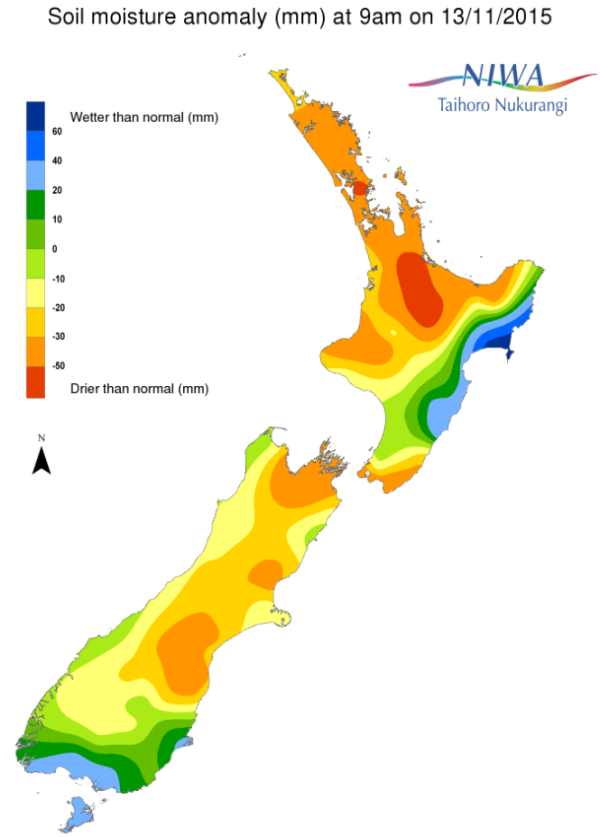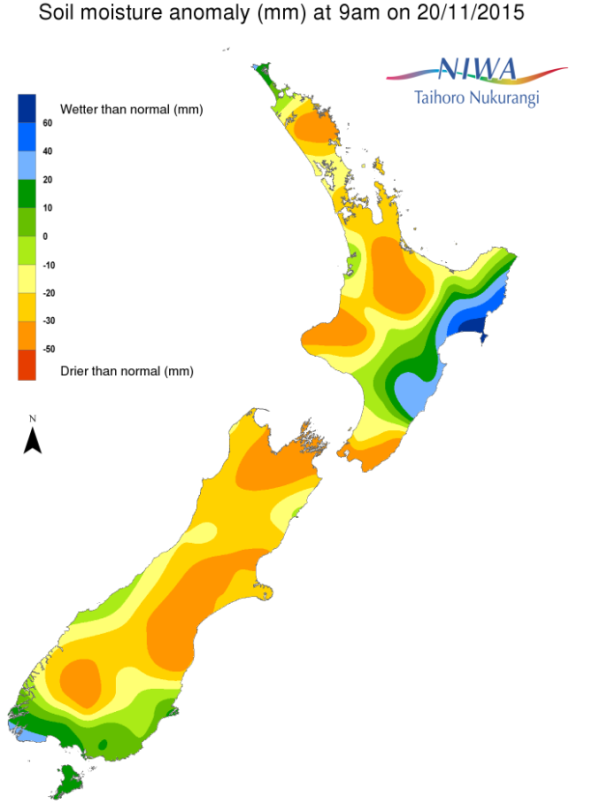A weekly update describing soil moisture across the country to help assess whether severely to extremely dry conditions are occurring or imminent. Regions experiencing these soil moisture deficits are deemed “hotspots”. Persistent hotspot regions have the potential to develop into drought.
Facts: Soil Moisture
For the North Island, soil moisture levels have increased or remained mostly unchanged when compared to this time last week. The driest soils are in the central and eastern sections of the Waikato and Wellington regions, as well as parts of the central Auckland and Northland regions. In these regions, soils are much drier than normal for this time of year. Wetter than normal soils for this time of year exist for the southern Gisborne and Hawke’s Bay regions.
In the South Island, soil moisture levels have decreased or remained largely unchanged compared to this time last week. Soil moisture levels from eastern Marlborough to far northeast Canterbury, roughly Blenheim to Kaikoura, are severely to extremely drier than normal for this time of year. Farther south, and east of the Divide, nearly the whole of eastern Canterbury to northeast Otago is experiencing much drier than normal soils for this time of year. Embedded in that area, from the southern Hurunui district in Canterbury to the Central Otago district, soil moisture levels are severely to extremely drier than normal for this time of year. The remainder of the island continues to experience near normal soil moisture conditions, with slightly wetter than normal soils for this time of year in and around coastal Fiordland.
Outlook
For the North Island, widespread rain is forecast to fall over much of the island through early Sunday morning. The rain will be heaviest and most significant in an east to west swath bounded roughly by the south Auckland and far northern Manawatu-Wanganui regions, with another area of significant rain likely near/along the Kapiti Coast. Widespread amounts of 5-15 mm are likely. However, in the aforementioned regions where significant rainfall is likely, upwards of 50-75 mm may occur. Thereafter, generally dry weather is likely through much of Wednesday with the threat for showers returning Thursday and/or Friday.
Consequently, soil moisture levels are likely to remain the same or increase for much of the island. The exception is likely to be from southern Gisborne to southern Wairarapa, where much less rainfall is anticipated. Here soil moisture levels will likely decrease over the next seven days.
For the South Island, once again rainfall distribution will be largely influenced by the Southern Alps. Along and west of the Divide, rainfall over the next seven days is expected to be generous, if not significant, with amounts tapering off dramatically east of the Divide, particularly in the Canterbury region as well as areas east of Nelson. As a result, soil moisture levels are likely to remain the same or increase for locations west of the Divide in the Southland to West Coast regions. The rest of the South Island will likely have soil moisture levels remain steady or decrease by this time next week.
Due to the recent rain and pending rain this weekend, hotspot regions for the North Island are confined to isolated pockets of south Wairarapa. For the South Island, hotspots exist from the Nelson region to eastern Marlborough as well as eastern Canterbury from about the Waiau River to central and northeast Otago.
Background:
Hotspot Watch a weekly advisory service for New Zealand media. It provides soil moisture and precipitation measurements around the country to help assess whether extremely dry conditions are imminent.
Soil moisture deficit
The amount of water needed to bring the soil moisture content back to field capacity, which is the maximum amount of water the soil can hold.
Soil moisture anomaly
The difference between the historical normal soil moisture deficit (or surplus) for a given time of year and actual soil moisture deficits.
Dry and extremely dry soil
Definitions: “Extremely” and “severely” dry soils are based on a combination of the current soil moisture status and the difference from normal soil moisture.
Check out NIWA's soil moisture maps
Soil Moisture Anomaly Maps
Pictured below soil moisture anomaly maps, relative to this time of year. The maps compare last week’s soil moisture anomaly with today’s.


